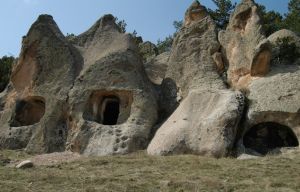This is Eskişehir Seyitgazi.
This is Eskişehir Seyitgazi.
Seyitgazi County is bordered on the north by Central County, on the northeast by Mahmudiye, on the west by Kutahya, on the south by Afyon, on the east by Çifteler and Han. It became a county in 1922.
Seyitgazi County is bordered on the north by Central County, on the northeast by Mahmudiye, on the west by Kutahya, on the south by Afyon, on the east by Çifteler and Han. It became a county in 1922.
Agriculture and animal husbandry are the most important sources of livelihood. In early times, the district was the scene of a very dense Hittite-Frig settlement. Under the name of Nakoleia, it became an important outpost during the Roman-Byzantine period. It's M. The S. Syed Battal Gazi, one of the heroes of Islam, was martyred during the Arab influxes into the region in the 740s. And it's named after the county. When Kanuni Sultan Suleiman 1533-1536 went to the Iraq Expedition, the army stayed in Seyitgazi and Matrakçı Nasuh painted a miniature of Seyitgazi. The travelogue of Evliya Çelebi (mid-17th century) contains the following information about Seyitgazi. This is the information about the pilgrimage. Oh, my God. This is where Seyid Battal Gazi is buried. Rum was martyred in the battles... With the approval of the Governor of Hacienda, a thousand households have been settled and enlarged... Oh, my God.
Who is Syed Battal Gazi? The famous Islamic commander is estimated to have lived in the 8th century. It is estimated that he lived in the century. In the wars of the Islamic armies against the Byzantines, he showed epic beings. He is said to have been born in Antioch, Damascus or Malatya. In the siege of Istanbul (M. The S. 717-718) and M. The S. His exploits in the campaigns up to 740 BC were told by the people as legends. He was martyred in a battle near Afyonkarahisar. It's been the subject of two great epics. The Arabic name Zatü ⁇ l-Himme and the Turkish name Battalname were given to Alâeddin Kaykubat's mother in 1207-1208. It was made into an ashtray by Ummouhan Hatun, the wife of Gıyaseddin Keyhüsrev. The town was named Seyitgazi.














